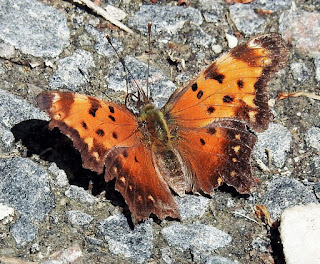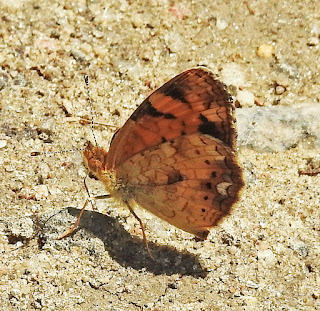Nature Moncton
Information Line…..May 26, 2018 (Saturday)
To
respond by email, please address your message to the Information Line Editor, nelson@nb.sympatico.ca
Please
advise the Editor if any errors are noted in wording or photo labelling.
For
more information on Nature Moncton, check the website at www.naturemoncton.com
Edited
by: Nelson Poirier nelson@nb.sympatico.ca
Transcript
by: Catherine Clements
Info
Line #: 506-384-6397 (384-NEWS)
**Clarence
Cormier had a visit from a BROWN THRASHER [Moqueur roux] to his Grande-Digue
site on Friday. He was able to get documentary photos. Two in one day’s report
is interesting, and they are a long way apart.
**Roger
Burrows suggests the Empidonax Flycatcher
featured in yesterday’s edition is a
LEAST FLYCATCHER [Moucherolle tchébec], noting the small bill, rounded
head, complete eye-ring, and short primary projection – interesting points to
consider when trying to separate suspected ALDER [Moucherolle des aulnes] or
Least Flycatcher from photos. Will attach some of these photos again today.
**Jean-Paul
and Stella LeBlanc spotted a pair of RUDDY DUCKS [Érismature rousse] in the
Bouctouche lagoon on Thursday and Friday. They were a long ways off, but
Jean-Paul was able to get a documentary photo of the male. There were also a
pair of NORTHERN SHOVELERS [Canard souchet], some BOBOLINKS [Goglu des prés],
many TREE SWALLOWS [Hirondelle bicolore], and one BANK
SWALLOW [Hirondelle de rivage] around the lagoon.
**Dave Christie comments that Friday marked the beginning of
normal migration of CEDAR WAXWINGS [Jaseur d'Amérique] in his area of Albert
County. A flock of 12 arrived to a tree near the Mary’s Point Interpretive
Centre. There were a lot of Cedar Waxwings that did remain in New Brunswick
over the winter, but normal return migration of this species that went south is
normally about this time. On Saturday, Dave spotted a NORTHERN MOCKINGBIRD
[Moqueur polyglotte] in the area where the Marsh Road in Shepody meets Route
114. Surprisingly, at the same time, Patricia Marshall, who runs the
Sandpipers’ Rest in that area, had a few unfamiliar birds in her yard and sent
Dave photos. One turned out to be a Northern Mockingbird, and the other a BROWN
THRASHER [Moqueur roux]. A bit of a coincidence to have these two species in
one yard. Dave is still getting a large number of RUBY-THROATED HUMMINGBIRDS
[Colibri à gorge rubis] that suddenly recently arrived, seeing 6 – 7 at once,
which usually means there’s a lot more in the area.
**Brian Stone sends some more very interesting photos and
scenarios from his Perth, Ontario stay. He experienced an explosion of
Caterpillars [Chenille] stripping leaves from trees the past few days. He said
it almost sounded like rain as he would walk down a path with Caterpillar frass
dropping steadily. They were rappelling down from their treetop heights on silk
threads. This is all a combination of two Caterpillar species in action at the
same time: the EASTERN TENT CATERPILLARS [Livrée d'Amérique] build those
compact “tents” and usually don’t go far to forage from their tents. The other
actor at work is the FOREST TENT CATERPILLAR [Livrée des forêts] which, despite
the name, do not build nests as such, but can travel across an area army-style,
eating everything green that’s in their path. I recall outbreaks in some areas
of New Brunswick of the Forest Tent Caterpillars in the past, but only smaller
local outbreaks recently. Brian has photos of both species. The broken line on
the back of the Forest Tent Caterpillar is a quick identification feature to
differentiate them from the Eastern Tent Caterpillar. Usually trees will
recover if this is only a one-time event. Brian also shares some Dragonfly
[Libellule] photos of ones like CHALK-FRONTED CORPORAL [la Julienne],
EBONY JEWELWING DAMSELFLY [Caloptéryx bistré], and FOUR-SPOTTED SKIMMER DAMSELFLY
[la Quadrimaculée] that we soon will be seeing here. Brian also got photos of a
JUVENALS DUSKYWING BUTTERFLY [Hespérie du chêne]. Note the white spots on the
wing to help identify it. This Butterfly is now widespread in southern Nova
Scotia, but there is only one record from New Brunswick. Jim Edsall comments it
is an OAK TREE [Chêne] feeder, and could well be present in small colonies in
Oak forests in southeastern New Brunswick as it approaches the border with
Maine. Definitely a species to watch for more in New Brunswick. Brian also
sends photos of the EASTERN TAILED BLUE BUTTERFLY [Bleu porte-queue de l'est],
NORTHERN CRESCENT BUTTERFLY [Croissant nordique], GRAY COMMA BUTTERFLY, and the brilliant green SIX-SPOTTED TIGER BEETLE
[Cicindèle à six points], all of which should soon be coming to life in New
Brunswick.
Nelson Poirier
Nature
Moncton
AMERICAN TOAD. MAY 23, 2018. BRIAN STONE
ANT CARRYING LUNCH. MAY 23, 2018. BRIAN STONE
BELTED WHITEFACE DRAGONFLY ( IMMATURE ). MAY 23, 2018. BRIAN STONE
CATERPILLAR INVASION STRIPPING TREES OF FOLIAGE. MAY 23, 2018. BRIAN STONE
CATERPILLAR INVASION STRIPPING TREES OF FOLIAGE. MAY 23, 2018. BRIAN STONE
CHALK-FRONTED CORPORAL DRAGONFLY. MAY 23, 2018. BRIAN STONE
EASTERN KINGBIRD. MAY 23, 2018. BRIAN STONE
EASTERN TAILED BLUE BUTTERFLY. MAY 23, 2018. BRIAN STONE
EASTERN TENT CATERPILLARS. MAY 25, 2018. BRIAN STONE
EBONY JEWELWING DAMSELFLY. MAY 23, 2018. BRIAN STONE
FOREST TENT CATERPILLAR. MAY 25, 2018. BRIAN STONE
FOREST TENT CATERPILLAR. MAY 25, 2018. BRIAN STONE
FOUR-SPOTTED SKIMMER DRAGONFLY. MAY 23, 2018. BRIAN STONE
GRAY COMMA BUTTERFLY. MAY 24, 2018. BRIAN STONE
GRAY COMMA BUTTERFLY. MAY 24, 2018. BRIAN STONE
GRAY COMMA BUTTERFLY. MAY 24, 2018. BRIAN STONE
JUVENAL'S DUSKYWING BUTTERFLY. MAY 23, 2018. BRIAN STONE
JUVENAL'S DUSKYWING BUTTERFLY. MAY 23, 2018. BRIAN STONE
LEOPARD FROG. MAY 24, 2018. BRIAN STONE
LEOPARD FROG. MAY 24, 2018. BRIAN STONE
NORTHERN CRESCENT BUTTERFLY. MAY 24, 2018. BRIAN STONE
NORTHERN CRESCENT BUTTERFLY. MAY 24, 2018. BRIAN STONE
NORTHERN CRESCENT BUTTERFLY. MAY 24, 2018. BRIAN STONE
NORTHERN SHOVELER (PAIR). MAY 24,2018. JP LEBLANC
RUDDY DUCK (MALE) WITH BLACK DUCK PAIR BEHIND. MAY 24,2018. JP LEBLANC
SIX-SPOTTED TIGER BEETLE. MAY 23, 2018._ BRIAN STONE


























